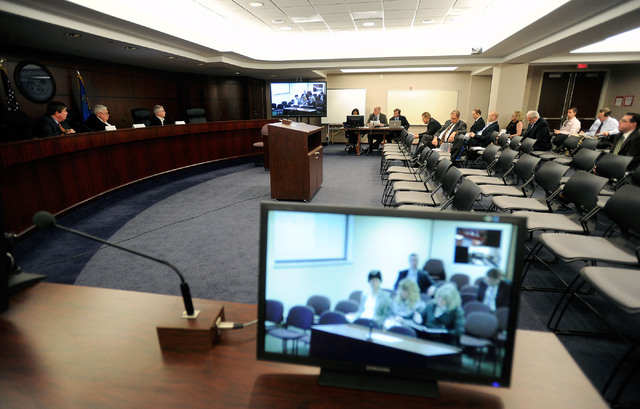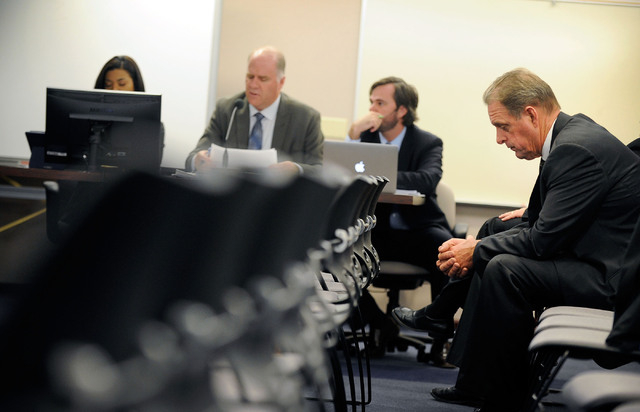North Las Vegas explores its dwindling options for economic recovery
Officials used to count North Las Vegas’ options for averting financial ruin on two hands.
Take away the city’s authority to freeze millions of dollars in long-sought union pay raises — as a District Court in Clark County did in January — and they might need only a couple of fingers.
District Judge Susan Johnson’s decision awarding public safety workers $25 million in back pay suspended under a city-declared “fiscal emergency” in June 2012 has prompted the city to roll out a $7.7 million blueprint to settle with its bargaining groups, one that union leaders say won’t be enough to satisfy more than 700 members.
Meanwhile, damage to the municipality’s credit rating already has been done.
The Jan. 21 ruling prompted a pair of downgrades for North Las Vegas’ already junk-rated municipal bonds, a reflection of Wall Street fears about the city’s ability to meet an estimated $428 million in short- and long-term debt obligations.
If the judgment isn’t stayed, overruled or settled out of court, the city could owe union employees about $41 million in back wages and increases — more than a third of this year’s budgeted spending.
Financial analysts with Fitch — the first of the big three credit rating agencies to downgrade the city’s financial outlook — find it “highly questionable” that officials would be able to make those payments.
The city’s bond rating, like an individual’s credit score, affects its ability to borrow money and finance new investments.
If North Las Vegas was an individual borrower, she already might have been left to the loan sharks.
“It appears unlikely that the city will be able to use a third consecutive state of emergency resolution to close the fiscal year 2015 budget gap, estimated at $18 million,” Fitch noted in a Jan. 24 report on the city’s financial state. “The city does not appear to have many other options for (closing its deficit) and is required to file a balanced budget.
“As such, the city would likely face insolvency or state receivership.”
Those count as just two of many possibilities, small and large, that could help the city of 229,314 step back from the brink.
STATE COULD TAKE OVER
Receivership, the state’s broadly untested statutory alternative to municipal bankruptcy, could be legally implemented in North Las Vegas soon.
Steep declines in property tax and general fund revenue have seen the city meet two of 27 takeover triggers outlined in the statute governing state declaration of a municipal “severe financial emergency.”
But the state hasn’t shown much interest in stepping in to cauterize the city’s fiscal hemorrhage, at least not yet.
State Committee on Local Government Finance members on Friday warned the city could face receivership if leaders can’t come up with a cost reduction plan by May 1.
They offered few clues as to what such a plan should look like or what else might prompt an intervention.
State Taxation Deputy Executive Director Terry Rubald has said she and others are encouraged by the city’s recent attempts to dig up cost savings through a proposed shared services agreement with nearly a dozen municipal departments run by Las Vegas.
Rubald, speaking to an 11-member panel created to explore the preliminary merger at a shared services meeting in January, told committee members their involvement in the city’s fiscal planning is one reason state tax officials have so far decided against “pulling the plug” on the state’s fourth largest city.
Rubald went on to offer a detailed teleconference presentation on the nuts and bolts of the state’s fiscal emergency statute, one that would allow tax officials to appoint a financial minder to oversee future union contract negotiations and employee hiring while implementing a plan to bridge the city’s yawning budget gap through tax increases and budget cuts.
It would not, she stressed, allow the city to void existing collective bargaining agreements or duck out on its debt obligations.
“It’s no guarantee that structural deficits can be overcome,” Rubald said. “It seems to me that if creditors don’t play ball, we’d have to explore how to get them to accept terms.”
North Las Vegas could ask state tax officials to hold the purse strings at any time, a move last adopted by Storey County, which faced steep deficits entering budget planning talks in 2004. It took four years for state officials to wrap up its work in the Northern Nevada county.
Councilwoman Anita Wood couldn’t say how far North Las Vegas would have to sink before she and other council members would ask the state to step in.
Much depends on how long the unions give leaders to learn how to swim.
“The unions will put the city out of business, there is no doubt about it,” Wood said Jan. 23. “We don’t have 40 cents on the dollar to settle with unions; we don’t have 30 cents, 20 cents or 10 — taxes are the only way to raise dollars for that settlement.”
Asked about that comment moments before the city found 31 cents on the dollar to settle with its bargaining groups, Wood stuck to her guns.
“We still don’t really have the money, but we’re doing our best to come up with creative solutions.”
LAW COULD BE REWRITTEN
The state doesn’t have to take a potentially mortally wounded North Las Vegas under its wing.
It could always rewrite Nevada’s severe fiscal emergency statute to allow what would qualify as one of the largest municipal bankruptcies in U.S. history.
Legislators could also revise the law to permit the city’s earlier fiscal emergency declaration, buying time for a hoped-for economic rebound.
Asked about the possibility of changing the rule book to better accommodate the city’s potential fiscal collapse, Assembly Speaker Marilyn Kirkpatrick said only that the statute as written “could use a little clarity.” She also hinted legislators might not have enough money in the state’s revolving fund to keep North Las Vegas on life support for long.
It’s not clear which of the city’s two worst-case scenarios — insolvency or state receivership — might count as the lesser evil to state leaders.
Kirkpatrick, whose district includes North Las Vegas, didn’t want to pick between the two.
“We have to get North Las Vegas from today until next February,” she said. “There is no special session to go in and change policy. ... We have to get them to February, then we can look at some other options.”
Fitch bond analyst Shannon Groff couldn’t speak to the likelihood of a state-sanctioned Chapter 9 filing, but said the possibility figured into her firm’s decision to drop the city’s debt rating.
Once one of the fastest-growing cities in the nation, North Las Vegas has shed more than 1,000 employee positions and shaved $211 million off its bottom line since 2008, leaving analysts little reason to believe the city can right itself under its own power.
Groff noted that the city can’t afford to pay its unionized public safety employees and seems unlikely to pay another municipality to take over its services.
That could leave its future in the hands of the state, a cold comfort to city debt holders.
“North Las Vegas has to file a balanced budget by June,” Groff said. “I don’t know how they’re going to do it and I don’t know whether the state will step in if they don’t, but even if they do step in, it seems (the city’s) only options are tax hikes or a loan from the state.
“I don’t see their (credit) rating going up anytime soon. I could see it going down if there are massive layoffs to help balance the budget in the future, that would be a major concern to us.”
UNINCORPORATION, OTHER OPTIONS
A third way out from under North Las Vegas’ bloating structural deficit would see the city’s reversion into unincorporated Clark County, a possibility state tax officials say could only come about through the failure of a yearslong restructuring process.
And a fourth would see city’s absorption into Las Vegas, a route that would require state authorization, but one that officials have laid some groundwork for with a proposed shared services agreement that could be adopted in May.
City employee unions have long balked at a regional consolidation model, citing concerns over autonomy and the feasibility of reconciling existing collective bargaining agreements with contract terms observed in neighboring municipalities.
Elected officials, despite sharing a detention center since 2012, have agreed public safety services would not be part of a preliminary department-level collaboration between the two municipalities announced in October.
Ruben Garcia, a professor at the University of Nevada, Las Vegas Boyd Law School, isn’t sure why consolidation has become something of a four-letter word for city stakeholders.
He said mediation or third-party arbitration still counts as the likeliest byproduct of the union contract ruling that sent the city’s bond rating tumbling.
But barring a miraculous economic turnaround — and assuming an economic picture as bleak as bondholders predict — Garcia said a neighborly bailout has to count as one among an ever-dwindling number of nonbankruptcy solutions.
“Consolidation with the city of Las Vegas would be an option,” Garcia said. “I would guess there’s some balance sheet out there tallying up the costs and benefits of that possibility.
“All the outcome of (January’s) opinion points to is an effort to try and work things out with bargaining groups in mediation or arbitration. If the city’s broke, those negotiations will, in theory, allow them to open up discussion on some of the other alternatives.”
Lisa Washburn, a managing director with bond research firm Municipal Market Advisors, came up with half a dozen ways some of those alternatives could give leaders a black eye.
That’s why Washburn is betting the state will try to avoid authorizing a messy bankruptcy, opting instead for a much tidier and “generally effective” state receivership plan.
She suspects consolidation, whether municipal or departmentwide, is the only other outcome bondholders can get behind.
“I think that it would be more likely for the city and state to want to pursue service consolidation opportunities over bankruptcy,” Washburn said. “Bankruptcy, even when permitted by a state to its local governments with no conditions, is typically an undesirable last resort for any municipality.
“Consolidation of services, or municipalities that achieve efficiencies (that) result in cost savings, are generally viewed as a credit positive.”
TAX HIKE A LONG SHOT
Of the few tools left in North Las Vegas’ fiscal tool belt, a property tax hike might be the sharpest.
It’s also the least politically feasible, a sure way to incite widespread gnashing of teeth among elected officials and constituents alike.
City Finance Director Darren Adair said the city retains rights to an additional 30 cents of revenue for every $100 of assessed valuation under state law, good for an estimated $8 million to $9 million a year. State tax overseers would have the leeway to raise taxes by $3.34 in an effort to appease city creditors.
But Adair, who took over the city’s books in September, isn’t getting his hopes up. He, like the credit rating analysts at Fitch, has come to see the move as “politically infeasible” — not even worth a place in the prediction models.
Fifteen percent of any future consolidated tax revenue and an untold percentage of any boost in property tax dollars would have to remain tied up in servicing debts incurred to build and maintain nine-figure investments in a new City Hall, wastewater treatment plant and 170-acre regional park.
Adair reckons those debt payments — coupled with an increasingly likely pay day for the city’s bargaining groups — have put the city in a hole even the state might struggle to fill.
“Many of (the city’s) bonds require interest rate payments before paying for city services,” he said. “If we can’t make those payments we would have to raise our tax rate and even revising the tax rate isn’t sufficient to manage the deficit in combination with pay freezes.
“So if you look at (the state’s) tools in a receivership scenario, those tools may be sufficient to resolve the deficit through 2021, but we can’t be the only ones the state reserves its funds for.”
City leaders didn’t quite break even on North Vista Hospital’s $1.9 million purchase of the city’s decades-old police headquarters last month, although a fire sale on other city capital investments might provide short-term relief for what ails the city’s balance sheet.
Adair said the city could expect to raise a few million dollars through the one-time sale of North Las Vegas’ long abandoned City Hall and Detention Center.
It could potentially pocket even more through rumored long-term lease agreements with everyone from the College of Southern Nevada to the Las Vegas Metro Chamber of Commerce.
City officials don’t deny that revenue from such moves withers quickly in the face of a projected seven-year, $152.6 million deficit.
It remains to be seen whether dozens of similar half measures can help make the city whole.
But Adair remains optimistic. “I wouldn’t be here today if I didn’t think we could turn things around,” he said. “I just hope we don’t run out of time.”
Contact reporter James DeHaven at jdehaven@reviewjournal.com or 702-477-3839. Follow him on Twitter at @JamesDeHaven.


















